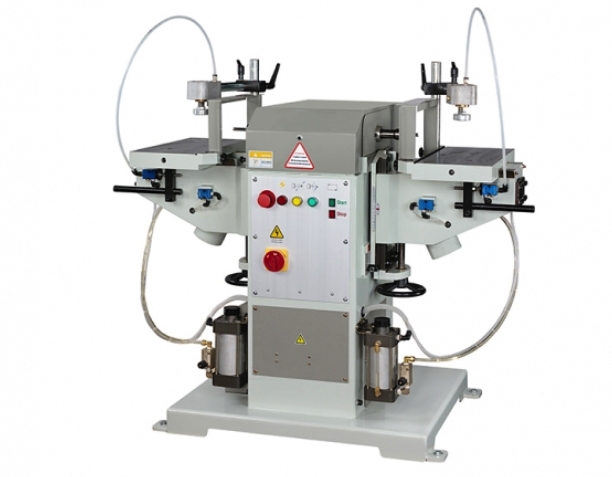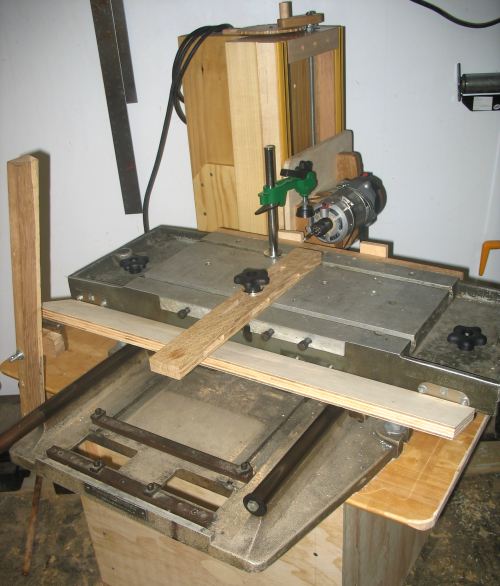Diy Slot Mortiser
Introduction: Horizontal Slot Mortiser
Tech in wood joinery meets handcrafted design + build. The top part is a mortising unit, below is a micro-adjust created using traditional methods. The story follows. I purchased this Jessem Mortise Mill unit a few years back and although I managed to produce some loose tenon slots successfully, it was not easy to set up. I can’t recall the issues exactly, but it was frustrating at times. So recently found the unit buried under a secondary workbench and decided I would make an effort at getting it to work successfully.
I had always wanted a horizontal slot mortiser setup and thought why not set this up to create slots in the horizontal plane instead of the vertical plane. The unit was marketed to be installed vertically with board placement underneath. Notice the etchings on the Mortise Mill are upside down. I’m not sure if having boards hanging below the unit contributed to the issues I had at the time, but nonetheless I wanted to mount it so loose tenon slots were created horizontally. Today, I use this slot mortise extensively in my furniture studio at Pirollo Design. Woodworking courses, woodworking plans and classes also available through WoodSkills
- Complexity is the big obstacle to most shop-built mortising machine plans. This design has a “keep-it-simple” philosophy. It’s mostly built from plywood parts that are glued and screwed together. The moving components — the router carriage and sliding table — operate with heavy-duty, full-extension drawer slides. A no-nonsense stop system and a commercial toggle clamp make cutting.
- Three Axis Slot Mortiser Plan Posted on: July, 18, 2016, in How would you like to be able to cut a mortise in less time than it took to read this sentence? Almost all of my students, and everyone who uses, or sees our shop made slot mortiser in action, just has to have one! Now you can build your own, using common shop materials and supplies!
Three Axis Slot Mortiser Plan Posted on: July, 18, 2016, in How would you like to be able to cut a mortise in less time than it took to read this sentence? Almost all of my students, and everyone who uses, or sees our shop made slot mortiser in action, just has to have one! Now you can build your own, using common shop materials and supplies! Horizontal Slot Mortiser: Tech in wood joinery meets handcrafted design + build. The top part is a mortising unit, below is a micro-adjust created using traditional methods. The story follows. I purchased this Jessem Mortise Mill unit a few years back and although I managed. Jig mortiser diy jig diy slot mortiser slot mortiser. 7 comments so far. Home projects blog. 1213 posts in 2091 days #1 posted 11:32 AM.
Step 1: A Suitable Platform
These images show the unit assembled to a rolling cart before building the micro-adjust unit. It was critical to find a suitable platform, i.e. workbench surface to be able to mount it. A rolling cart in my workshop was ideal since I could wheel the unit away when not in use and the footprint of the Mortise Mill was not large. The rolling cart has large locking casters which do a good job of keeping the cart immobile. I installed it so the surface of the base plate was even with the surface of the cart, this took some time. Large enough 1/4-20 bolts were used to maintain rigidity and keep it from shifting.
Tested it afterwards and I was pleased with the results. The later addition of a L-shaped wood bracket to support stiles while they were being mortised worked well. The ends of rails to be mortised were easily supported by the wood surface of the rolling cart. Further testing with clamping of boards provided me with a repeatable setup. I liked the fact that I could permanently leave the Mortise Mill bolted to the rolling cart and continue to use the complete top surface of the rolling cart as before.
Rojek Slot Mortiser
Step 2: Micro-Adjust
An issue that soon came up was the vertical adjustment of the mortise slots on a horizontally-oriented board. Since the Mortise Mill was installed horizontally with horizontal board placement instead of vertical, the slot location adjustment was not as smooth as I would like due to the weight of the sliding component of the unit. I decided to build a micro-adjust setup to alleviate the problem. This was performed using some scrap walnut and maple. As can be seen in the pic, it is all wood construction with a 1/2 inch lead screw and wood handle. The end of the lead screw has a custom cradle contoured to fit the bottom edge of the sliding part of the Mortise Mill. Now I could precisely dial-in slot placements!
Step 3: Horizontal Slot Mortiser
Since the micro-adjust is cantilevered off the vertical posts of the rolling cart, I beefed up the supports. It is probably over-engineered now. Things to watch are the exact placement of the tip of the lead screw over the center of the edge of the Mortise Mill for smooth operation. A large paddle switch for the built-in Mortise Mill dust collection was installed for convenient access. The end result is a functional horizontal slot mortiser that provides precise adjustment of the slots. The rolling cart top serves as an excellent support for boards as can be seen in the images. The other images demonstrate how accurate the slots are for loosed tenon installation.
I don't have a plan for this at this time as you would need to acquire the Jessem Mortise Mill for this particular setup. Other plans, woodworking courses and classes are available at: WoodSkills

1 Person Made This Project!
- woodskills made it!
Recommendations

Plywood Challenge
Plastic Contest
Battery Powered Contest
Introduction: Horizontal Slot Mortiser
Tech in wood joinery meets handcrafted design + build. The top part is a mortising unit, below is a micro-adjust created using traditional methods. The story follows. I purchased this Jessem Mortise Mill unit a few years back and although I managed to produce some loose tenon slots successfully, it was not easy to set up. I can’t recall the issues exactly, but it was frustrating at times. So recently found the unit buried under a secondary workbench and decided I would make an effort at getting it to work successfully.
I had always wanted a horizontal slot mortiser setup and thought why not set this up to create slots in the horizontal plane instead of the vertical plane. The unit was marketed to be installed vertically with board placement underneath. Notice the etchings on the Mortise Mill are upside down. I’m not sure if having boards hanging below the unit contributed to the issues I had at the time, but nonetheless I wanted to mount it so loose tenon slots were created horizontally. Today, I use this slot mortise extensively in my furniture studio at Pirollo Design. Woodworking courses, woodworking plans and classes also available through WoodSkills
Step 1: A Suitable Platform

These images show the unit assembled to a rolling cart before building the micro-adjust unit. It was critical to find a suitable platform, i.e. workbench surface to be able to mount it. A rolling cart in my workshop was ideal since I could wheel the unit away when not in use and the footprint of the Mortise Mill was not large. The rolling cart has large locking casters which do a good job of keeping the cart immobile. I installed it so the surface of the base plate was even with the surface of the cart, this took some time. Large enough 1/4-20 bolts were used to maintain rigidity and keep it from shifting.
Tested it afterwards and I was pleased with the results. The later addition of a L-shaped wood bracket to support stiles while they were being mortised worked well. The ends of rails to be mortised were easily supported by the wood surface of the rolling cart. Further testing with clamping of boards provided me with a repeatable setup. I liked the fact that I could permanently leave the Mortise Mill bolted to the rolling cart and continue to use the complete top surface of the rolling cart as before.
Step 2: Micro-Adjust
An issue that soon came up was the vertical adjustment of the mortise slots on a horizontally-oriented board. Since the Mortise Mill was installed horizontally with horizontal board placement instead of vertical, the slot location adjustment was not as smooth as I would like due to the weight of the sliding component of the unit. I decided to build a micro-adjust setup to alleviate the problem. This was performed using some scrap walnut and maple. As can be seen in the pic, it is all wood construction with a 1/2 inch lead screw and wood handle. The end of the lead screw has a custom cradle contoured to fit the bottom edge of the sliding part of the Mortise Mill. Now I could precisely dial-in slot placements!
Diy Slot Mortiser
Step 3: Horizontal Slot Mortiser
Since the micro-adjust is cantilevered off the vertical posts of the rolling cart, I beefed up the supports. It is probably over-engineered now. Things to watch are the exact placement of the tip of the lead screw over the center of the edge of the Mortise Mill for smooth operation. A large paddle switch for the built-in Mortise Mill dust collection was installed for convenient access. The end result is a functional horizontal slot mortiser that provides precise adjustment of the slots. The rolling cart top serves as an excellent support for boards as can be seen in the images. The other images demonstrate how accurate the slots are for loosed tenon installation.
I don't have a plan for this at this time as you would need to acquire the Jessem Mortise Mill for this particular setup. Other plans, woodworking courses and classes are available at: WoodSkills
1 Person Made This Project!
- woodskills made it!
Recommendations

Diy Slot Mortiser Block
Plywood Challenge
Plastic Contest
Battery Powered Contest